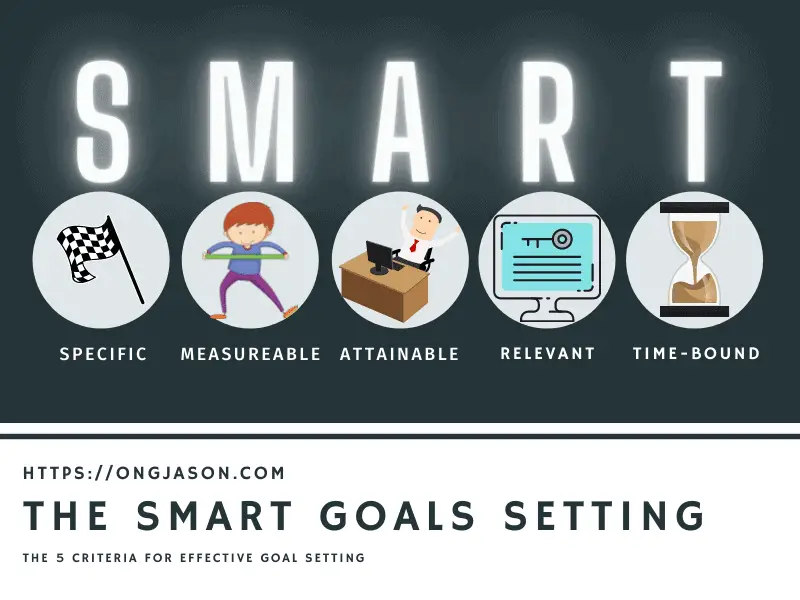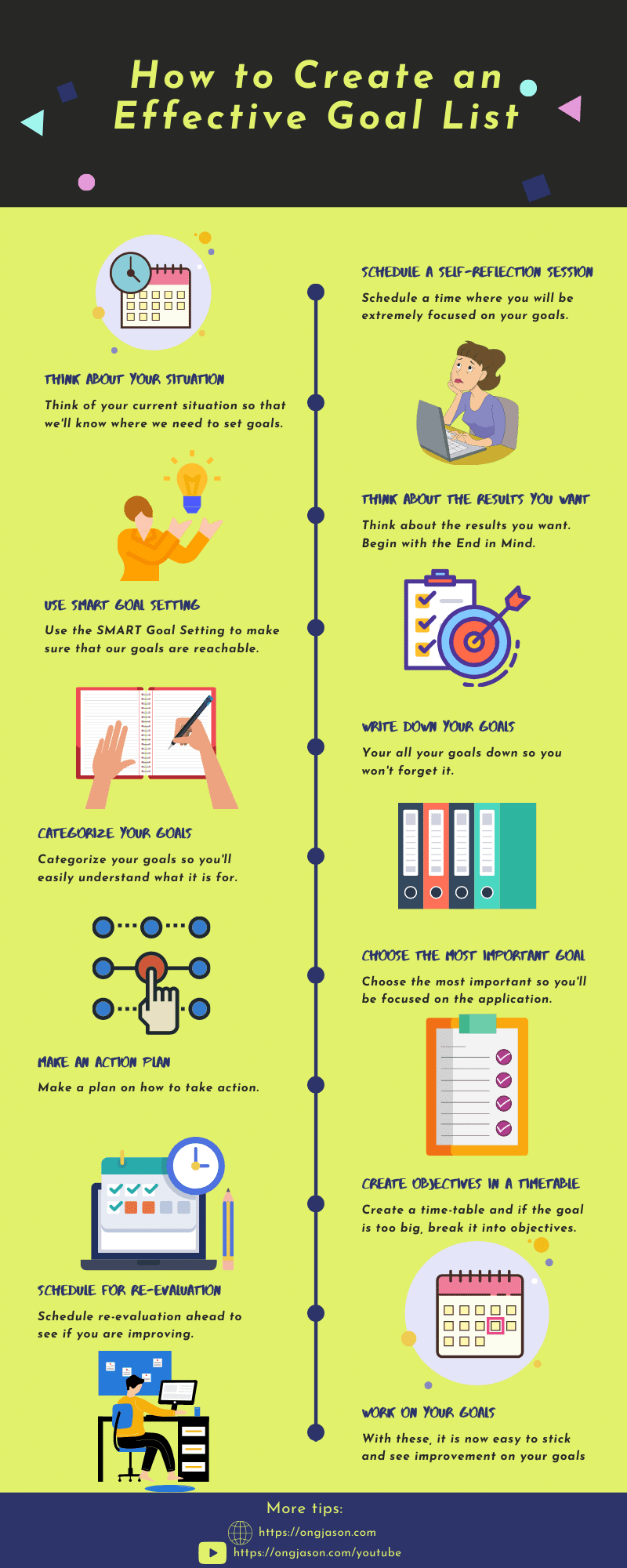How to Create a List of your Goals [11 Effective Steps]
Goals are a set of objectives that we as individuals desire or want. In short, goals are what make us want to achieve things. However, goals are quite hard to accomplish without any planning, and listing your goals is actually one way to help us plan. Properly listing your goals is essential if you want to make things clear and doable. Thus, this article will be about how do we list our goals.
Listing our goals is actually done effectively by first, carefully categorizing your goals. After carefully categorizing, set them using the SMART criteria(specific, measurable, attainable, relevant, and time-bound), and find the one that is the most important in order to apply these goals.
People usually fail in reaching their goals because they are usually failing in the planning phase. There can be two reasons, one is that they set a lot of goals thus, their focus is fragmented, two is that they didn’t use the SMART criteria in goal setting. We are going to make sure in this article that we will be focusing on the most important goal and making our goals fit in the SMART goal settings criteria. Thus, we will discuss how to properly create a goal list.

Here is how you create a goal list:
- Schedule a Self-Reflection Session
- Think about Your Situation
- Think about the results you want
- Use the SMART goal setting criteria
- Write down your Goals
- Carefully categorize your goals
- Choose the Most Important Goal
- Make an Action Plan
- Create Objectives in a timetable
- Schedule for Re-evaluation
- Work on your Goals
That is the summary of the actionable steps on how to create a goal list. To further explain why are these steps necessary, this article will discuss all of these steps in greater detail and will make examples if necessary. So Let’s start.

Step 1: Schedule a Self-Reflection Session
It is important to schedule a self-reflection session when listing our goals because we need absolute focus in order to carefully plan our objectives in order to reach the goal we want. Without focus, we can’t produce the best result we can get from goal setting.
The first step in listing our goals is to schedule a self-reflection session.
The reason for this is because we need focus in order to plan. Remember that planning is the most important part of reaching our goals because it makes us work smart.
While I am a believer in working hard, I believe that working smart makes the difference. In fact, research has proven that working hard plus working smart produces a 270% increase in productivity.
That’s almost 3x the productivity we can have. Thus, with intense focus, we can carefully make a plan of action in reaching our goals.
If you need help on how to properly do a self-reflection, then I recommend you read this article where I discussed how to do self-reflection properly and effectively: How to develop your self-reflection practice
But the idea here is to save time and to get the best result we can possibly have in our session. Remember that our goal is to make an effective goal list.
Step 2: Think about Your Situation
Thinking about your current situation is important in creating a goal list because we need to have a proper assessment of where we are right now in order to properly prepare for the future. Goals are what we want to achieve and without knowing where to start, we will be lost.
Most people go straight out in making goals without thinking of their current situation.
Without knowing your current situation, we can’t possibly know where to go.
It is like going to a place without knowing where you exactly are. Even the apps on our phones need our location before teaching us how to go to places.
That is because without knowing where you actually are, it is hard to plan carefully.
For example, when I was starting to get serious about this website, I got some data on where my website currently is at that time. That way, I can track how much increase in traffic does my site gets on a monthly basis.
That is the same for you. If you want to lose weight, then know your current weight. It is important to know where we are starting and not directly making plans and objectives to reach a goal.
Step 3: Think about the results you want
Thinking about the results we want is important in goal setting because we need to have the right target in order to achieve our goals. Without having the correct target, we might get lost on what do we need to do and might do things that can harm our real goals.
Now that we know where we are right now, it is time to plan on where do we want to go.
For example, in weight loss, if your starting weight is 220 lbs, then it is time to put your goal weight.
If you are planning to fix your finances, then it is time to set the goal such as how much saving you want to have, or how much debt do you want to get rid of.
Furthermore, without knowing the result we want, we can harm our goals.
For example, if our goal is to lose weight, then we don’t want to have any other goals that might make us gain one such as sitting more at work instead of working out.
Thus, our goals depend on what we want. We have to start with the end in our minds. We need to know where we want to go if we want to succeed.
The next step is to make our goals ultimately better because it will make our goals easy to follow and doable.

Step 4: Use the SMART goal setting criteria
The SMART criteria for goal setting is one of the most important steps in making our goals doable. It makes our goals easy to follow since using the criteria makes our goals specific, measurable, attainable, realistic, and time-bound. Without these guidelines, we will have a hard time following our goal.
Now that we have focus, know where we are and where we want to go, it is time to use the smart guidelines in order to make our goals very easy to follow.
This is the SMART goal criteria.
- Specific
- Measureable
- Attainable
- Realistic
- Time-bound
We have to make sure that our goals are specific. This means, for example, we do not just want to lose weight but we want to be more specific like we want to lose 10 pounds.
Measurable means that it can be measured. Like in the example above, we can measure how much weight we can lose. We can also measure how much money do we want to get. We can measure how much do we want to save.
Attainable means that our goals should not be too big for us. The reason for this is that we humans tend to always freeze when we are having a goal that is too much for us to handle.
This happened to me when I was first starting out a website. Since I have no clue how to make one or writing blog posts, I froze for about 5 years. I wanted to make a website ever since I was in college but I never did it because I just feel that the plan was too big for me to attain.
The trick here is to make things realistic.
Realistic means that we need to make our goals easy. For example, if my goal was to make a website, I should’ve just learned first how to get a domain name, and then make my first website.
It’s actually not that hard if you divide it into objectives.
When I thought making a website is very unattainable, I was thinking of the websites of famous bloggers that are beautifully designed. But it shouldn’t be that way.
We can make things real for us by dividing a hard goal into smaller steps.
Lastly, time-bound.
It is irrelevant if we have a goal without any deadline.
For example, I plan to publish 30 articles this month.
This means that my plan has a timeline in which I need to make 30 articles this month.
So let’s set my example of 30 articles this month as an example.
My goal is specific and measurable because of the 30 articles. It is also attainable because I can actually write about 4000 words per day if I am in a mood then about 2000 if I’m not. An average blog post is about 1000 words. Thus, it is also realistic.
Lastly, I will finish it in a month so there is a time limit.
The importance of time limit is to prevent procrastination which almost all of us are guilty of. This gives a sense of urgency for us to do something to our goals.
Examples of SMART goals are the following:
- I am going to lose 10 lbs of weight in a month
- I am going to schedule a meeting with my boss this week
- I am going to be debt free next year
- I am going to have a side job next quarter
- I am going to travel to Europe next year
Your turn.
Step 5: Write down your Goals
Writing down your goals on a piece of paper or in your computer is important because our brains are not good at storing information. Writing things down makes us not forget our goals and objectives and makes us focus on identifying more goals.
If you see the examples of SMART goals above, I made them into a list.
That’s because the next step is to list them down somewhere.
If you are also following the self-reflection article, it is said in there that we have to write things down on a piece of paper or even on your phone.
This is to use our brain on something it is good at and that is processing information.
As soon as we get SMART goals, write them down then think of another. We can have as many as we want right now because we will need the list later and when we do another self-reflection session.
Step 6: Carefully categorize your goals
Categorizing your goals is necessary in order for us to see which among the goals is the most important to us as of now. This sets a priority on which goals do we need to focus on depending on the current situation we are in since priorities are important for proper implementation.
Now that you’ve listed all of the goals you want to achieve, it is time to categorize them.
The reason for this is because we need to find out which among our goals are the important ones to do. We are not good at multitasking so we need to find the most important ones.
To do this, we have to know the categories of goals.
I have a guide for you in this step and I believe it is important to check it out if you don’t know how to categorize your life goals: How to Categorize your Goals
But basically, you need to categorize your goals into 10 areas.
Here are the categories of goals:
- Financial Goals
- Health Goals
- Relationship Goals
- Psychological Goals
- Educational Goals
- Personal Development Goals
- Experience Goals
- Spiritual Goals
- Career Goals
- External Goals
For more information, check out this link: How to Categorize your Goals
The goal in this step is to find which among these categories do we need the most improvement on. In that article, I gave the example of the lowest point in my life where I realized that the one I needed the most at that time is to set goals for my financial goals.
The result will be different for you. You might want to serve other people thus external, or you may want to have a new career thus, educational or career.
Now, put your SMART goals into categories.

Step 7:Choose the Most Important Goal
Choosing the most important goal is very important so we can have focus on what we do. Humans are not good at multitasking so working on many goals at the same time is a bad idea. In order to achieve big things in life, we have to learn how to focus.
Now that we have categorized our goals, find out which category needs the most attention. It could be your financial, health, or whatever category you choose.
The reason for this is that making too many goals is a recipe for disaster.
There are two main reasons why people fail in their goals. One is that they didn’t have a SMART goal, two is that they have too many goals.
While it may look cool to have many goals we follow and try to improve upon, it is very counter-intuitive since we are not really good at multi-tasking.
If you really want to have many goals, then the best way is to put things into smaller chunks and into a habit. But I really recommend you to find one goal that will make all the others also better.
There is something like that. For example how I realized that fixing the financial aspect of my life would result in an increase of almost all my needs for other categories.
Step 8: Make an Action Plan
Making an action plan is needed for implementing our goals because we need a proper plan to achieve things efficiently. This means that we are having a plan to do something every day to achieve our goals and it can help in preventing us from wasting precious time.
Now that you’ve chosen the one goal we want to make, or you’ve chosen more than one, then it is time to make a plan of action.
The plan of action is very simple. Know what you need to do daily or weekly in order to reach your goals.
For example, if you want to lose weight, then you need to have a meal plan and a workout routine in order to reach your goals.
As a tip, it is good to turn things into a habit because it prevents us from losing our willpower.
This is the reason why I am against having a lot of goals. Too many goals or to-do will make us lose willpower fast thus, most people fail to finish their goals because they might be too big, or too many.
Step 9: Create Objectives in a Timetable
Creating objectives and a timetable in goal setting is important because it helps us track where we are going with our goals. Without measuring the results we should have in a timetable, we might get lost on our goals Furthermore, hard goals can be diced into objectives in a timetable.
As you can see, there are 2 important reasons for a timetable.
One is to track the results we are supposed to have, another is to cut big goals into smaller objectives.
An example is losing weight. If we want to lose 10 lbs in 1 month, then we might have a timetable where we should lose 2 lbs in a week or something like that.
Thus, the big goal, which is losing 10 lbs can be cut off to losing 2-3 lbs every week. This makes the goal easier to accomplish because we have a weekly target.
Furthermore, in case you didn’t reach your smaller goals, then it is a sign that what you’ve been doing is not very effective so it may be time to change some things.
As you can see, a timetable is necessary for effective goal list creation. It makes the result easy to track and easy to change if is it not working. Thus, saving our time.

Step 10: Schedule for Re-evaluation
Scheduling for re-evaluation is essential for goal setting because you need to have a follow-up on your goal settings. The reason why most goal settings don’t work is that it lacks the follow-up on what you’ve currently at. Thus, re-evaluation is necessary.
Before working on your goals, you first need to schedule a re-evaluation.
It must be placed in your timetable when you want to have a re-evaluation.
Furthermore, it is also good to have a re-evaluation after reaching your goals so you can use the list you’ve made to target another goal you want to achieve.
The reason why most new year’s resolution doesn’t work is that it lacks the re-evaluation step. It is not wise to re-evaluate every year because it is very long.
The best is to re-evaluate on a weekly or monthly basis.
Step 11: Work on your Goals
The planning phase of making a list of goals is good. Furthermore, effective goal setting makes it even better. But following it up with really working on your goals will make the real results we are looking for. Thus, planning is irrelevant without work.
Now that you have a very effective plan for goal setting, it is time for you to do the most important part.
Planning is irrelevant without work. You can have the most efficient goal list and setting but without the work to do it, it will be completely useless.
So now that you have a clear goal, timetable, and schedule for re-evaluation, it is time to work on your goals.
With the steps prior to working on your goals, you will be extremely more efficient.

“Only the things I love.“
ongjason.com is reader-supported. When you buy through links on the site, I earn an affiliate commission.
If you’re following me, you’ll know that I believe it is essential to have some tools, whether it’s for personal development or lifestyle in general.
So, here are the things I love.
YouTube
If you want to learn things for free, I recommend watching my YouTube Channel. Click the Button Below to go straight into my Channel. 🙂
Okay, let me first explain my Channel.
I believe that I really can’t explain everything too well on my blog. That’s why I created a YouTube Channel so I can easily explain a lot of things. Plus, I believe that Video Sharing is the future.
Recommended Books
The next thing is books. Books are, for me, one of the cheapest ways to get invaluable information. We can learn personal development, finance, career, relationships, and many more from books.
Here, I will be listing my favorite books in different categories.
- For Beginners – 7 Habits of Highly Effective People by Stephen Covey – Personal development has a lot of concepts and ideas to learn. Thus it can be really hard for beginners to know where to start. Thus, I recommend this book since all the basic concepts of personal development are here(except finance, check what I recommended for that)
- Productivity – The One Thing by Gary Keller – This book teaches us the power of focusing on one thing which is the ultimate source of productivity. The concepts taught are what I am using to constantly publish YouTube videos while maintaining this website.
- Busy? – Make Time by Jack Knapp – This book teaches us how to make time for the things we love. The concept is really simple but I think that makes it a book worth reading.
- Health – Lifespan by Dr.Sinclair – This Book teaches about the latest scientific research on lifespan. In his book, he has shared numerous things he is doing to slow down his aging process. This can be as easy as eating less which he recommends.
- Finance – The Richest Man in Babylon by George Clason – Perhaps one of the first books I’ve read about Finance, this book for me is the best if we are talking about learning basic finance such as basic saving and investing. The concepts are very simple but effective.
Audiobooks
Take this advice as a grain of salt.
I don’t recommend buying Audiobooks one by one. I mean, audiobooks can be quickly finished by listening while working out or doing some mindless tasks.
So here is to save you some money. Just go for a monthly subscription to Audible. I believe that you will save a lot of money with that plus, they usually give freebies to anyone starting.
My Audiobook Recommendation will always be the same as my book recommendations, but I personally like The 5 Second Rule by Mel Robbins. I like how she is so casual while reading her book.






